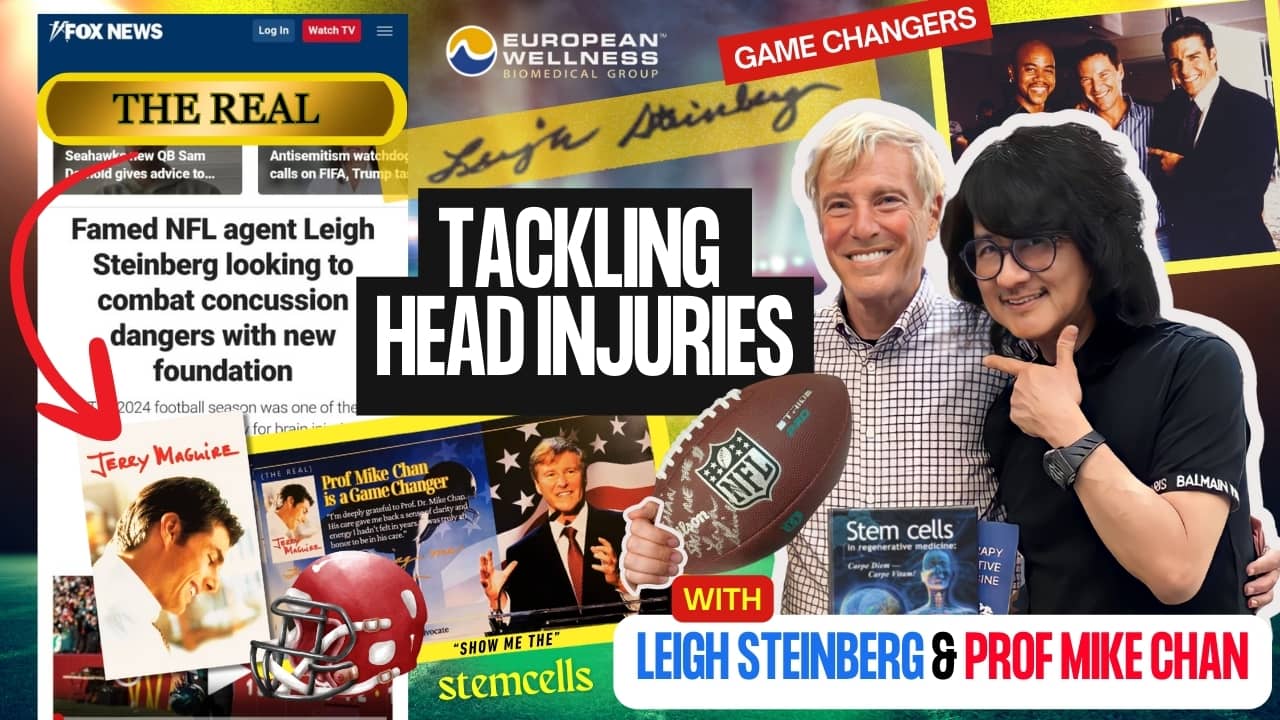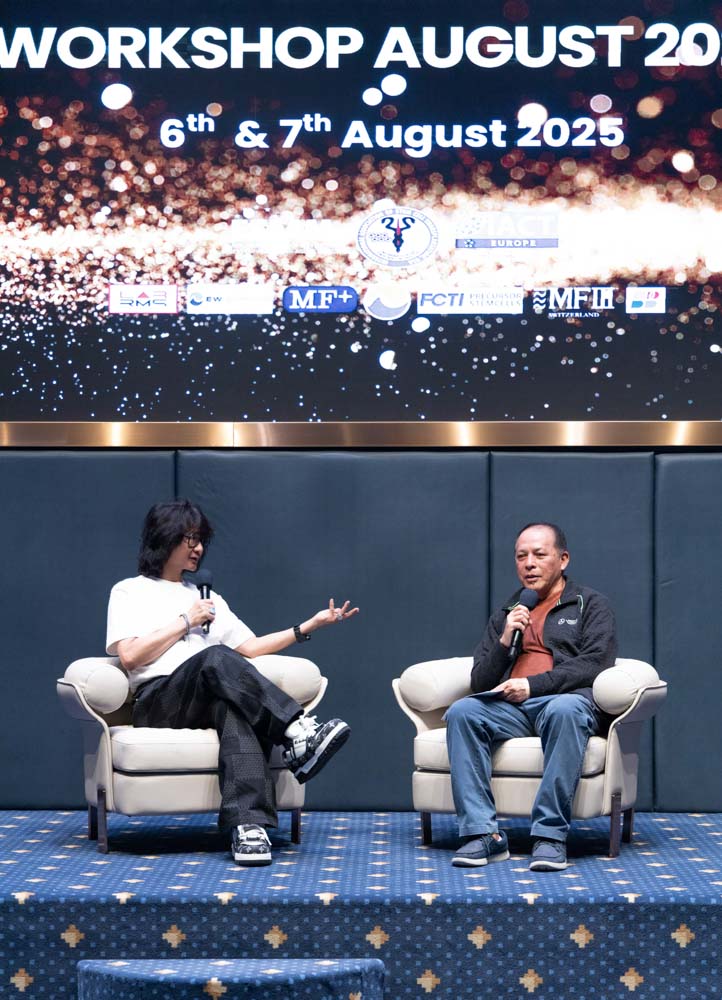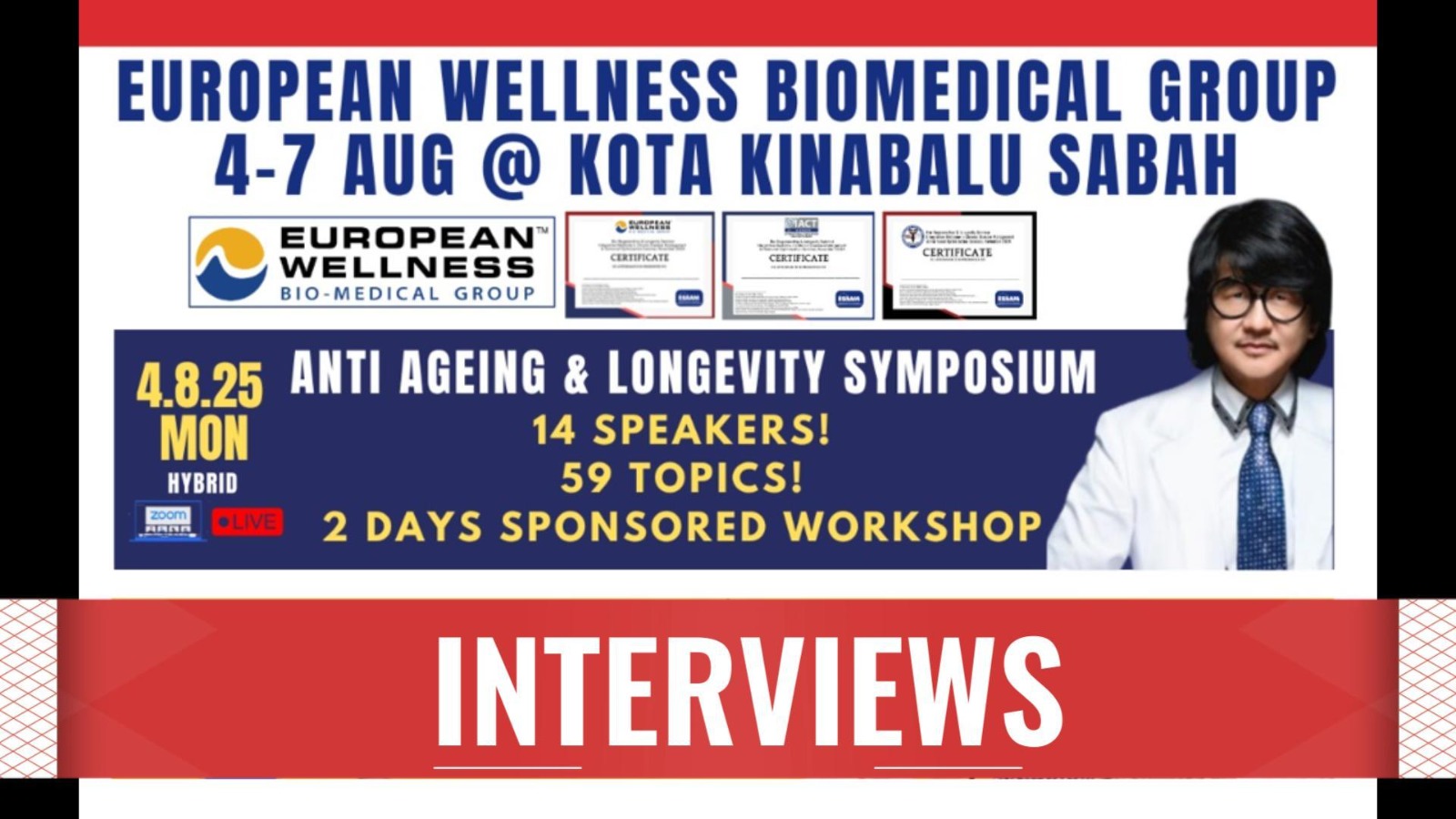KANGAR, Perlis (9 August 2025) — Just a day after his landmark royal audience with…
GAME CHANGERS: The Real Jerry Maguire Meets Prof. Mike Chan to Tackle Concussions and Sport Injuries
The man who inspired the multiple award-winning movie “Jerry Maguire” meets the pioneering stem cell scientist who is transforming regenerative medicine. Together, they may just hold the key to healing the silent epidemic of sports-related brain injuries.
A New Alliance for Athlete Brain Health
It was a meeting destined to make headlines. Leigh Steinberg, the legendary sports agent who inspired the Hollywood film Jerry Maguire, and Prof. Dr. Mike Chan, a globally acclaimed stem cell scientist, recently came together in what may be the start of a groundbreaking alliance. One built some of the most iconic careers in sports; the other is revolutionizing regenerative medicine. Their shared mission: to bring hope and healing to athletes whose lives and careers have been compromised by brain trauma.
Their encounter was far more than symbolic. Prof. Chan personally treated Steinberg using targeted stem cell therapy—with Steinberg experiencing significant results overnight. In a heartfelt social media post, he wrote:
Last night was a revelation. My sciatica eased by this morning. I posted on social media and was flooded with inquiries about your services. I am now the president of the Dr. Chan Fan Club International.
Reflecting on the experience, Steinberg added: “I was excited when Prof. Mike Chan was coming to treat me. I knew stem cells were at the forefront of modern medicine. And meeting him confirmed it—he’s warm, charismatic, and deeply reassuring. I was also impressed by his erudite scholarship and the body of work he’s published.”
Anyone in my age group who’s trying to extend life and quality of life—I think these stem cells are an integral part of health and wellness. That’s where Prof. Mike Chan is far ahead of many in his field. He’s spent years studying and treating. Being treated by the person who wrote the book probably augurs well for success.
For two men who’ve reshaped their respective industries, this collaboration signals a new era in athlete care—one driven by compassion, precision medicine, and a shared commitment to changing the game.
The Real Jerry Maguire’s Mission
Leigh Steinberg is no ordinary agent. Having represented more than 300 professional athletes, including NFL MVPs and Olympic gold medalists, his name is synonymous with elite sports management. But his true calling lies in advocacy. For decades, Steinberg has spoken out on behalf of athletes suffering from the long-term consequences of concussions and chronic traumatic encephalopathy (CTE).
“Back in the 1980s, I was representing half the starting quarterbacks in the NFL and they kept getting hit in the head. And after that there was an exponentially higher rate of Alzheimer’s, Parkinson’s, premature senility, chronic traumatic encephalopathy, and depression,” Steinberg shared. “So getting the athlete to protect themselves is no easy matter. The particular difficulty with athletes is being in a culture of denial about their physical situation. So, I had a crisis of conscience.”

About the Leigh Steinberg Foundation
Leigh Steinberg is no ordinary agent. Having represented more than 300 professional athletes, including NFL MVPs and Olympic gold medalists, his name is synonymous with elite sports management. But his true calling lies in advocacy. For decades, Steinberg has spoken out on behalf of athletes suffering from the long-term consequences of concussions and chronic traumatic encephalopathy (CTE).
It’s not just about protecting athletes—it’s about protecting futures.
Founded by the legendary sports agent, the Leigh Steinberg Foundation is dedicated to creating a future where mental health, brain trauma, and concussion recovery are not only better understood but actively treated with compassion and innovation. Through strategic partnerships, research funding, and advocacy, the foundation empowers underserved communities, educates the public, and champions long-term solutions for those affected by traumatic brain injuries.
“We recently set up a concussion foundation which has its purpose, raising money for new research and awareness. We also try to provide treatment for underserved communities that don’t necessarily have a way to deal with brain health,” Steinberg said in a recent interview with Fox News.
Recent research reveals the depth of this crisis:
A study by Mass General Brigham found that 1 in 3 former NFL players believe they have CTE, and those with this belief reported significantly higher rates of depression, cognitive difficulties, and suicidal thoughts. Additionally, Boston University’s CTE Center revealed that 92% of former NFL players’ brains examined postmortem had signs of CTE.
Steinberg is a key supporter of mental health initiatives, player protection programs, and long-term recovery solutions—a commitment rooted in compassion and experience. His goal: to ensure that an athlete’s legacy includes not just career highlights, but lifelong wellness.
The most important thing is long-term health,” Steinberg said. “And far below that would be playing a pro career, and below that, playing a given game. The least significant thing is ‘does this play.’”
Prof. Mike Chan: Bioregenerative Breakthroughs in Brain Injury Recovery
“I believe the future of brain injury treatment lies in the precision in precursor stem cell therapy in bioregenerative medicine. With the right protocols and the right platform, we can help thousands of athletes regain clarity, stability, and peace.” – Prof. Mike Chan.
Prof. Mike Chan, chief scientist and founder of European Wellness Biomedical Group, has led the field of regenerative medicine for over 40 years. With dozens of books, scientific publications and international awards, his work focuses on reversing damage from degenerative diseases using targeted precursor (progenitor) stem cells and integrative biological therapies.
“No one can stop aging but we can definitely reverse aging by 6 to 16 years and further delay the rapid biological progression,
“As long as there are living tissues and cells in any of our 78 aging organs, even if they are dying, age reversal is possible because we can still regenerate the cells.”
Brain injuries—especially concussions and repetitive trauma commonly seen in sports like American football, are not just medical challenges; they are regenerative opportunities,” says Prof. Chan. “By understanding the body’s cellular communication and repair mechanisms, we can restore impaired brain and body functions, as well as vitality, in ways that conventional medicine cannot.”
Prof. Chan’s signature DDRR™ protocol—Diagnose, Detox, Repair, Rejuvenate—outlines a meticulous four-phase approach, which is detailed in the book Stem Cells in “Biological Wellness” co-authored by Prof. Mike Chan and Prof. Dr. Dmitry Klokol. This book presents their integrated approach combining Western and traditional Asian medical systems, with stem cell therapy as a core component of the DDRR protocol.
- Diagnose: Comprehensive assessments begin with an advanced analysis of trauma history, oxidative stress levels, hormonal imbalances, lipid and nutrient deficiencies, and toxic exposures—using cutting-edge tools and bioregenerative expertise to uncover hidden dysfunctions and guide personalized treatment.
- Detox: Clearing the internal terrain of neurotoxins and body toxins to optimize receptivity to therapy.
- Repair: Introducing hyperbaric oxygen therapy (HBOT), BioSleepWave, myofascial decompression, and most importantly, region-specific precursor stem cells.
- Rejuvenate: Ongoing therapies to enhance neuroplasticity using phosphatidylcholine supplementation, mitochondrial revitalization, and lifestyle optimization.
“This is not guesswork,” Prof. Chan explains. “We use neural precursor stem cells that are individually prescribed to target and regenerate damaged tissues, restore neural impulse conductivity, and—through advanced delivery methods—effectively bypass the blood-brain barrier.”
Prof. Chan emphasizes that the brain is one of the most complex organs, composed of numerous functional zones and 52 distinct regions with 67 types of stemcells and transcription factors and cellular signaling profiles. Just as the human body contains more than 400 specialized types of stem cells, the brain alone requires a highly customized, region-specific approach to regeneration.
Targeting the Brain with Precision: Organ-Specific Stem Cell Therapy
One of the most groundbreaking aspects of Prof. Mike Chan’s methodology is the precise, bullseye-targeted application of organ-and-brain-specific precursor stem cells. Unlike conventional, generalized stem cell therapies, the protocols at European Wellness are meticulously customized to focus on the exact regions of the brain and spinal cord most affected by trauma.
“Every concussion, every neural injury carries its own biological fingerprint,” Prof. Chan explains. “That’s why we prescribe highly specific precursor cells—targeted to areas such as the frontal lobe, hippocampus, cortex, cerebellum, brainstem, or spinal cord—based entirely on each patient’s unique diagnostic profile.”
For instance:
The frontal lobes are responsible for executive functions such as decision-making, impulse control, emotional regulation, and concentration. The temporal lobes, on the other hand, are central to memory formation, auditory processing, and language comprehension. In NFL players, repeated impacts often result in microtraumas to these regions, leading to symptoms like brain fog, memory lapses, emotional instability, and difficulty concentrating.
Targeted precursor stem cells directed to these lobes are used to:
- Enhance synaptic repair in memory-related circuits (e.g., hippocampus, entorhinal cortex)
- Rebuild damaged white matter to restore signal speed and coherence
- Stabilize mood and cognitive processing by modulating neurotransmitter levels such as dopamine and serotonin
- Reduce cortical thinning linked to long-term concussion exposure
“Our advanced, organ and brain specific, targeted precursor stem cell and peptide therapies are designed not only for neurological repair but also to support critical athletic systems such as the lungs, heart, and adrenal glands, as lifespan of lungs is at 20 while heart is at 40,” explains Prof. Mike Chan.
“By enhancing oxygen uptake, strengthening cardiac output, and optimizing adrenal response, we can help athletes achieve faster recovery, sustained endurance, and the performance-driven adrenaline surge essential for peak physical output.”
Emotions and composure on the day of the event define the greatest moment of a sportsman’s life—and this integrated therapy ensures the body and mind are both prepared to rise to that occasion.
When we target the frontal and temporal lobes, we’re not just aiming to restore memory or attention,” says Prof. Mike Chan. “We’re reigniting the very regions that give an athlete their sharpness, confidence, and emotional control.
The cerebellum plays a vital role in balance, fine motor skills, reaction time, and spatial awareness—functions that are often impaired in athletes post-concussion. The brainstem, particularly the midbrain and medulla, controls autonomic functions like heart rate, breathing, reflexes, and basic motor control.
Damage here can cause:
- Vertigo, poor balance, and difficulty walking
- Slowed reflexes and impaired coordination
- Headaches, dizziness, and eye movement disorders
- Disrupted sleep-wake cycles and autonomic instability
Organ-specific stem cells targeted to these zones help:
- Restore proprioception and fine motor skills
- Reduce postural tremors and gait instability
- Reinforce neuron-glia interactions essential for motor memory and muscle control
- Protect the brain’s balance centers by reducing inflammation and oxidative stress
“Athletes may appear physically capable post-injury, but struggle with subtle motor issues that affect performance and safety,” explains Prof. Chan. “Regenerating cerebellar pathways can return that edge.”
The spinal cord acts as the main communication highway between the brain and the rest of the body. In high-impact sports, cervical spine injuries, disc compression, and spinal neuroinflammation are frequent—even without full paralysis.
Athletes with spinal cord involvement may experience:
- Radiating nerve pain, muscle weakness, or numbness
- Loss of coordination or speed in limb movement
- Autonomic dysfunctions like irregular heartbeat or bladder issues
- Chronic inflammation that delays healing or causes neural scarring
Targeted brain specific precursor stem cell therapies applied to the spinal cord region aim to:
- Stimulate remyelination of damaged nerve fibers to restore fast signal conduction
- Enhance axonal regeneration in partially injured neurons
- Reduce astrocyte-driven scarring and neuroinflammation
- Re-establish reflex pathways and muscular communication
“Even when spinal damage is subclinical, it affects performance, posture, and long-term quality of life,” Prof. Chan notes. “Targeted organ-and-brain-specific precursor stem cells offer us a chance to reconnect the signals that drive movement and function.”
These tissue-derived stem cells, ethically sourced and rigorously matched, act as cellular messengers and repair agents.
“This is where biology meets bioengineering,” says Prof. Chan. “We’re restoring lost communication networks and offering what drugs never could: regeneration from within.”
“Not all stem cells are created equal,” adds Prof. Mike Chan. “There must be precision in both diagnosis and therapy. You cannot apply a generic approach—what works for one condition may be completely ineffective for another.”
He likens it to a genetic blueprint: each disease, each organ—even each region of the brain—requires a specific cell type and transcriptional signature. Just as the human body contains over 400 distinct types of stem cells, the brain alone consists of 67 functionally unique neural structures, each requiring tailored therapeutic strategies.
“You don’t treat A1 with Z10,” he adds. “It must be A1 for A1, B6 for B6, and so on. That’s the science of targeted precision.”
Stem Cell Therapy: A Promising Avenue Backed by Research
Beyond Prof. Chan’s work, the broader scientific community is echoing similar breakthroughs.
A clinical trial by the University of Texas Health Science Center found that infusions of stem cells significantly reduced inflammation and preserved brain tissue related to memory and cognition in trauma cases.
This targeted approach, especially when applied to brain-specific regions, allows physicians to hit what Prof. Chan calls the “bull’s eye” of regeneration—delivering the right cells, to the right tissue, at the right time.
He draws from classical healing philosophy to summarize the ethos:
Similia Similibus Curentur”—‘let like be treated by like.
Meanwhile, high-profile NFL athletes are already seeking stem cell-based solutions:
- Chris Johnson, former NFL running back, credited stem cell injections with extending his playing career by four seasons.
- George Kittle, current San Francisco 49ers tight end, reported marked improvement after undergoing stem cell therapy, inspiring multiple teammates to do the same.
A Collaborative Vision for the Future
Both men believe that the partnership can go far beyond one successful treatment. By combining Prof. Chan’s clinical science with Steinberg’s advocacy and outreach, the initiative could set new global standards for post-career athlete rehabilitation.
What makes this partnership unique is its heart. Steinberg has long maintained that sports agents must be stewards of their athletes’ futures, not just deal-makers. Prof. Chan, likewise, champions dignity, vitality, and longevity for every patient—celebrity or not.
Well, I’m hopeful of taking some of his treatments into the world of professional sports and then collegiate sports. And if you can validate something in the athletic context because of the high profile and glamour of the field, then it takes you out to better acceptance in the remainder of the community.
Show Me The Stemcells
The phrase “Show Me The Money!” may have defined Leigh Steinberg’s Hollywood alter ego. But today, a new and far more meaningful mantra emerges: “Show Me The Stem Cells.”
This is no longer just about managing injuries—it’s about restoring lives, dignity, and long-term health. With Prof. Mike Chan’s cutting-edge regenerative therapies and Steinberg’s unwavering commitment to athlete well-being, a transformative shift is underway.
Together, they are building a future where brain injuries are not a career-ending sentence but a treatable condition—with real hope, real healing, and real results. For the countless athletes suffering in silence, this partnership could be the turning point.
“This is a calling,” Steinberg reflects. “It’s time we took real action for the people who gave everything to the game. And I believe this work can lead the way.”
Science has found its cause. And it could possibly change the future of the NFL—forever.

Further Reading: Some of Prof. Mike Chan's Publications
Get the full collection of Prof. Mike Chan’s groundbreaking books in stem cell therapy and bioregenerative medicine here: https://european-wellness.eu/books
Follow European Wellness Academy:


